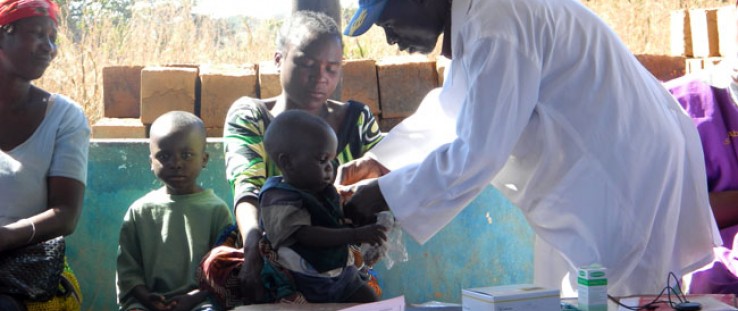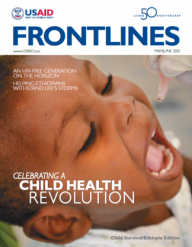 Community health workers provide check-ups for children under the LINCHPIN program.
Save The Children
Community health workers provide check-ups for children under the LINCHPIN program.
Save The Children
 Community health workers provide check-ups for children under the LINCHPIN program.
Save The Children
Community health workers provide check-ups for children under the LINCHPIN program.
Save The Children
Health Worker Article Series
Madagascar: Keeping Mothers Safe to Be Mothers
Kenya: Support from Clinic to Hospital to Home
Zambia: Coordinating Roles and Connecting with Care
Mozambique: Strength in Community Care
Bangladesh: Family Planning for Healthier Futures
Timor-Leste: Walking Together on the Long Road to Health
Alice Londaisha is a traditional birth attendant in the Chantete Health Center at the far end of Lufwanyama district in Zambia. Chantete is a community with no public transportation and no motorized vehicles of any kind. In November 2011, Londaisha escorted a pregnant woman on foot for 5 kilometers to the health center for delivery, consistent with the new role for traditional birth attendants in the district.
Upon arrival she found that the center’s trained nurse-midwife had travelled to Kitwe, a city about four hours away. Two community health workers were attending the facility in the nurse’s absence.
When Londaisha took the pregnant woman to the labor ward to examine her, she found the woman was pregnant with twins—and both babies were in breech position. This was an obstetrical emergency demanding care at a higher-level facility. Londaisha immediately alerted the health workers that the woman needed to be transferred to the hospital in Kitwe.
This coordination is a hallmark of the LINCHPIN project. The Lufwanyama Integrated Neonatal and Child Health Project in Zambia is implemented by the Lufwanyama district health management team and Save the Children under a cooperative agreement with USAID. The new approach teams birth attendants, community health workers and neighborhood health committees to improve access, availability neaccess, availability and quality of newborn care and community case-management interventions.
“As a team, we decided we had to make personal contact with the nurse. But none of us had a cell phone, so one of us rushed to the nearby house of the teacher who let us use hers. We got in touch with the nurse, who called the Lufwanyama district health office to get the ambulance,” recounts Londaisha. “Throughout the four-hour journey, I stayed with the woman and monitored and reassured her. When we reached the [health office], a nurse-midwife was assigned to join us the rest of the way to Kitwe Central Hospital. The next day, the health center’s nurse got in touch to let me know the twins had been delivered by caesarean section and that mother and babies were all fine.”
LINCHPIN is sharing lessons learned with the Ministry of Health and other partners at the national level, and is helping to coordinate the national effort to standardize community health-worker tools and job aids and improve monitoring and evaluation.









Comment
Make a general inquiry or suggest an improvement.